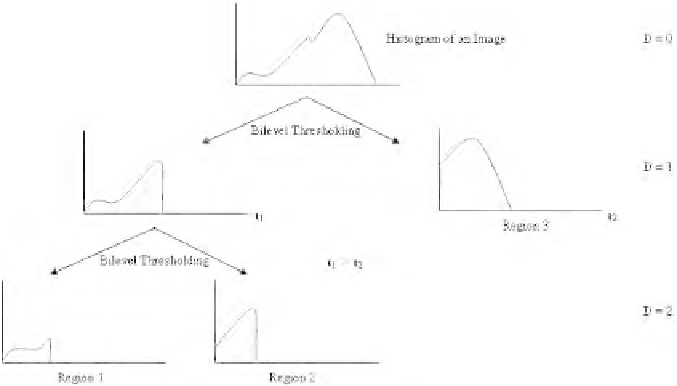Image Processing Reference
In-Depth Information
FIGURE 3.6: Separation of a histogram into three regions using the proposed multilevel thresh-
olding based on association error
values of g
a
(see Section 3.4.1) corresponding to the histogram region as follows
ι =
X
g
a
∈
Err
d
(g
a
) + Err
b
(g
a
)
(3.45)
(
g
d
,g
b
)
where g
a
, g
d
and g
b
are the same as explained in the previous section, except for the fact
that they are defined for the underlying histogram region and not for the entire histogram.
We use the expression in (3.45) to measure the suitability of the application of the bilevel
image thresholding technique to all the regions in the graylevel histogram at the depth
D−1. Larger the value of ι for a region of the graylevel histogram, more is the corresponding
average association error and hence more is the suitability. Hence, in order to get Θ regions,
we declare the bilevel thresholding of 2
D
−Θ least suitable (based on ι) regions at depth
D−1 as invalid and hence we are left with Θ regions at depth D. Now, as a region in the
graylevel histogram of an image corresponds to a region in the image, the aforesaid multilevel
thresholding would divide the image into Θ regions. Figure 3.6 graphically demonstrates
the use of proposed multilevel thresholding technique using association error in order to
obtain three regions (Regions 1, 2 and 3) in the histogram. The values ι
1
and ι
2
gives the
suitability of the application of the bilevel thresholding on the two regions at depth D = 1.
3.5
Experimental Results
In this Section, we demonstrate the utility of the proposed entropy measures and effec-
tiveness of the proposed image thresholding methodology by considering some image seg-
mentation and edge extraction tasks. Grayness ambiguity measure based on the proposed
entropies are employed to carry out image thresholding in order to perform image segmen-
tation and edge extraction. As mentioned in Section 3.1, the aforesaid image thresholding
is performed in two ways, namely, by the ambiguity minimization method reported in (Pal
et al., 1983) and by the image thresholding methodology proposed earlier in this chapter.
Results obtained using a few popular existing image thresholding algorithms are also con-




Search WWH ::

Custom Search